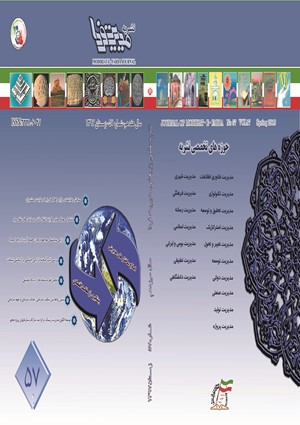Designing a Management Model for Acceptance New Media Technologies (Media Convergence emphasis
Subject Areas :Babak Rahnavard 1 , Kamran MohamadKhani 2 , Aliakbar Farhanghi 3 , Amir Hossein Mohammad Davoudi 4
1 -
2 -
3 -
4 -
Keywords: Media Convergence New Media Technology Acceptance Media strategy Technology Transfer,
Abstract :
This study aim, design a model for acceptance and transfer new media technologies (media convergence emphasis), research methodology is applied research(descriptive) and data collection methods implemented with mix method (qualitative and quantitative),at first stage, researcher reviewed a literature in media technology transfer to identification effective components and indicators, at qualitative part of the research, Selected 10 media industry experts to interviewed for identify effective indicators, in quantitative research part, researcher made questionnaire was distributed in the statistical sample of 300 responder from the population of the study and 285 questionnaires were returned. After analyzing , questionnaire responses with Spss software, Cronbach's alpha coefficient (reliability) was obtained α=0.881 and finally using structural equation modeling (SEM), to design a model, evaluation of the model show an absolute fit index (root mean square error 0.094 and chi-square 0.00), Incremental Fitness index of 0.886 and Frugal Fitness index 3.48 ,which indicates the acceptability of the model is introduced and to determine the degree of appropriateness, the second questionnaire was designed and distributed to responds by 30 experts of media and communications, analyze with one sample t test of utility models at 95 percent approval, then using the Friedman test measures the highest and lowest on the model, they were ranked
1. اومانا رولا، هنسون(1390). تکنولوژي هاي جديد ارتباطي در کشور هاي در حال توسعه، ترجمه حيدري ، داوود، تهران. مرکز مطالعات رسانه.
2. اكبري و همكاران(1393). بررسي تاثير مجذوب شدن و ويژگيهاي وب سايت بر رضايت و استفاده كاربران از شبكه اجتماعي (مطالعه موردي فيس بوك)، فصلنامه تحقيقات بازاريابي نوين، جلد ۴، شماره ۲، صفحات ۹۵-۱۱۰
3. بابايي،محمود (1392). رسانه هاي ديجيتال: مشارکت پذيري و فناوري محوري، ماهنامه گفتمان علم و فناوري، دوره 1، شماره2.
4. خجسته باقرزاده، حسن و همکار (1392).مدل هاي تطابق با تکنولوژي در رسانه، فصلنامه رسانه، سال بيست و چهارم، شماره3.
5. روشندل اربطاني، طاهر و همکاران (1390). بررسي اثرات همگرايي بر مديريت رسانه هاي خبر چاپي، مورد مطالعه روزنامه همشهري، نشريه مديريت دولتي، دوره3، شماره8، صفحات 39-56.
6. فرهنگي، علي اکبر و همکاران (1388). طراحي مدل تعامل مديريت رسانه و فناوري هاي نوين اطلاعاتي و ارتباطي، فصلنامه پژوهش هاي ارتباطي، سال 16، شماره 4.
7. فرهنگي، علي اکبر و همکار (1394).ارتباطات بازاريابي يکپارچه ، تهران انتشارات مهربان نشر.
8. سريزدي، علي و همکار (2011)، تحليل تاثير تکنولوژي بر رفتار سازماني با استفاده از رويکرد پويايي هاي سيستمي، اولين کنفرانس بين المللي مديريت تکنولوژي.
9. ناظمي، شمس الدين و همكار .(1391). معرفي و آزمون مدل مفهومي پذيرش و انتقال فناوري اطلاعات و خدمات اينترنتي در بين دانشجويان دانشگاه مشهد، فصلنامه علمي- پژوهشي دانش مديريت و اطلاعات، دوره28، شماره1 صفحات 181-202.
فهرست منابع انگليسي:
10. Albarran,A .B.S.M. Chan-Olmsted, and M.O .Wirth. (2006). Handbook of media Management and Economics, L.Erlbaum Association
11. Alrafi, A. (2006). Technology Acceptance Model Retrieved 4th February 2009, from www.imresearch.org/RIPs/2005/RIP2005-4.pdf.
12. Ajzen,I. Fishbein,M .1980.understanding attitudes and predicting social behavior. Prentice- hall, englewoodcliffs.
13. Aris, A. & Bughin, J. (2005). Managing Media Companies, Wiley Publications.
14. Atkin, David & et al .2015. Diffusion theory in the new media environment: toward an integrated technology adoption model, No 18 pp. 623- 650.
15. Chen, L., Gillenson, M. L., & Sherrell, D. L. (2002). Enticing online consumers: An extended technology acceptance perspective. Information & Management, 39(8), 705–719.
16. Phillips, Jasmine R(2014). "Examining Predictors of U.S. Student Intent to Study Abroad from a Communication Perspective" Open Access Dissertations. Paper 1346
17. Brown, T. E., Davidsson, P., &Wiklund, J. (2001). An operationalization of Stevenson’s nceptualization of entrepreneurship as opportunity-based firm behavior. Strategic Management Journal, 22, 953–968.
18. Chuttur, Mohammad .2009. Overview of the Technology Acceptance Model: Origins, Developments and Future Directions, Indiana University, USA . Sprouts: Working Papers on Information Systems, 9(37). http://sprouts.aisnet.org/9-37.
19. Dailey L, Demo L, Spillman M (2003). The convergence continuum: a model for studying collaboration between media newsrooms. [Online] Available: http://web.bsu.edu,
20.
21. Jenkins, H., & Deuze, M. (2008). Editorial: Convergence Culture. Convergence: The International Journal of Research into New Media Technologies, 14(1), 5–12.
22. Klinenberg, E. (2005). Convergence: News production in a digital age. Annals of the American Academy of Political and Social Science, 597(1), 48-64.
23. Kolodzy J (2006). Convergence journalism: Writing and reporting across the news media. Lanham, MD: Rowman & Littlefield Publishers, Inc.
24. Lin, C. A. (2003). An interactive communication technology adoption model. Communication Theory, 13, 345–365.
25. Lin, C. A. (2009). Exploring the online radio adoption decision-making process: Cognition, attitude, and technological fluidity. Journalism & Mass Communication Quarterly, 86, 884–899.
26. Napoli, P. M. (2008). Towards a model of audience evolution: New technology and the transformation of mediaaudience. Paperwork. The Donald McGannon Communication Research Centre. New York.
27. Rogers, E. M. (1995). Diffusion of Innovations (4th Edition). The Free Press, New York, USA.
28. Renaud, Karen, Biljon, Judy (2008), Predicting technology acceptance and adoption by the Eldry: a Qualitative study, SAICSIT 08, University South Africa.
29. Olmsted, Chan (2006), Issues in Media Management and Technology, Handbook of media management and economics, L. E Associates, Publisher, and Mahwah, New Jersey London.
30. Venkatesh, V., Morris, M.G., Davis, F.D., and Davis, G.B. (2003), User Acceptance of Information Technology: Toward a Unified View, MIS Quarterly, 27, 425-478.
31. Zhang, Sheng.(2012). the convergence of conventional media and new technology in the case of the new York time broadcastion.p293.


